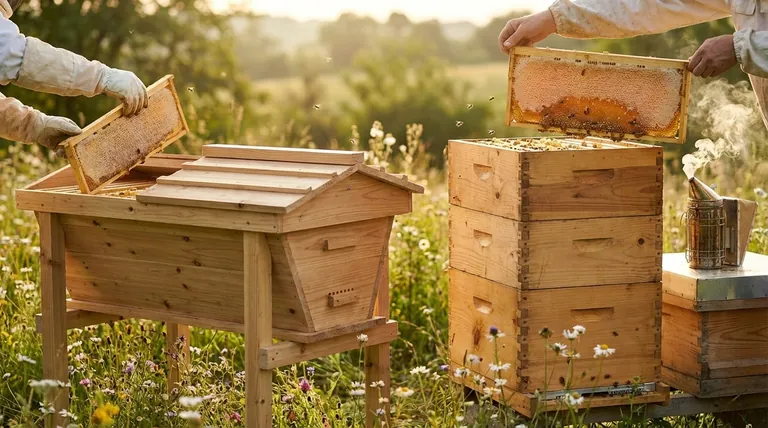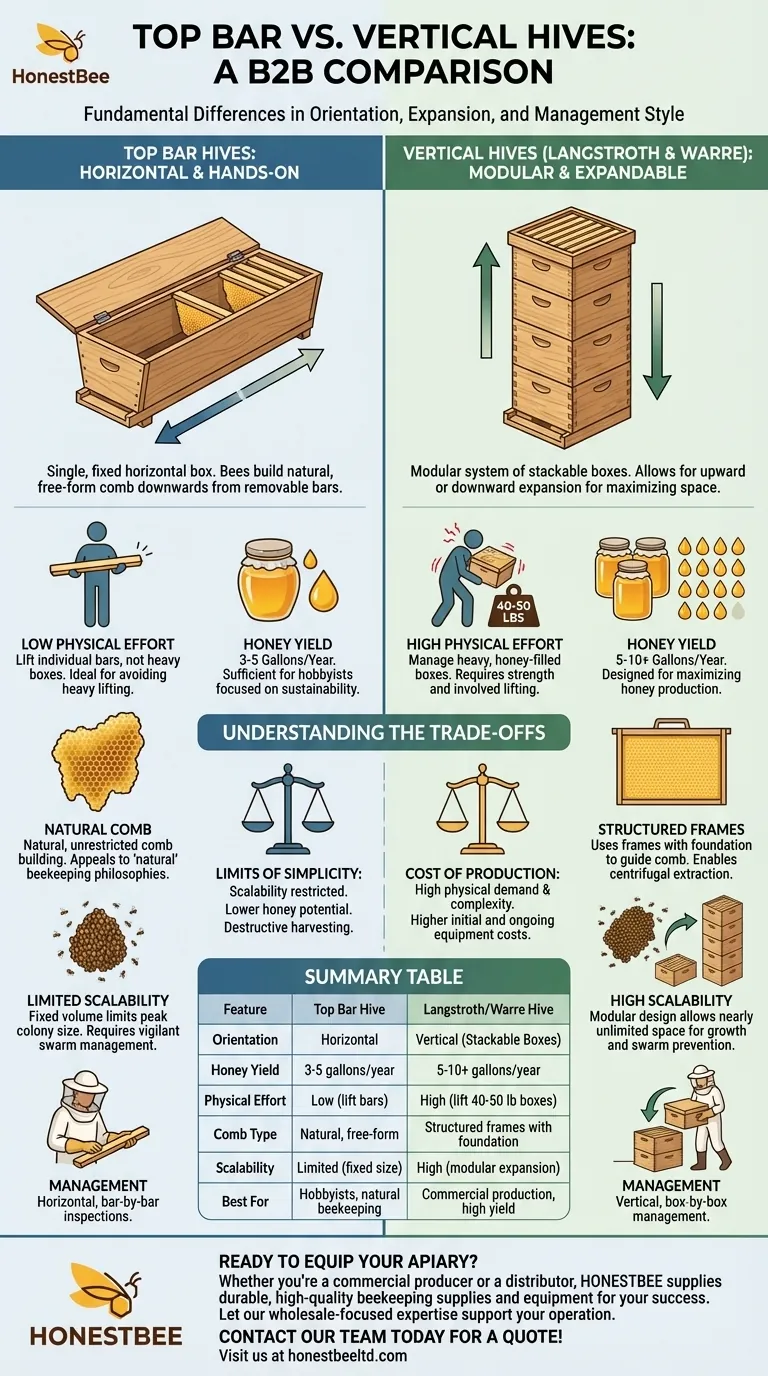The fundamental difference between a top bar hive and vertical hives like the Langstroth or Warre lies in their orientation and method of expansion. A top bar hive is a single, horizontal box where bees build comb naturally downwards from removable bars, while vertical hives are modular systems of stackable boxes that allow for upward or downward expansion. This core design difference dictates everything from management style and physical effort to honey yield.
Choosing a hive is not about which is "better," but which is better suited to your personal goals as a beekeeper. The decision fundamentally balances management simplicity and a more natural approach (Top Bar) against higher honey production and scalability (Vertical Hives).

The Core Design Philosophy
The shape and structure of a hive directly reflect a philosophy of bee management. Understanding this is the first step in choosing the right system for you.
Top Bar Hives: Horizontal and Hands-On
A top bar hive is a self-contained unit. It's essentially a long trough with wooden bars laid across the top.
Bees build their comb directly from these bars, creating natural, free-form structures. Management involves inspecting the hive one bar at a time, moving horizontally through the colony.
Because the hive is a single box, it never requires lifting heavy, honey-filled supers. Some models even feature hinged lids for easier access.
Vertical Hives (Langstroth & Warre): Modular and Expandable
Vertical hives are built around stacking boxes. The Langstroth is the most common, where new boxes (supers) are added on top as the colony grows and needs more space for honey.
The Warre hive operates on a similar vertical principle but involves adding new boxes to the bottom. This more closely mimics a wild bee colony's tendency to build downwards.
In both systems, the ability to add boxes allows the colony to scale significantly, a key factor for maximizing honey production.
A Practical Comparison for the Beekeeper
Your day-to-day experience will be vastly different depending on the hive you choose. Here is a breakdown of the key operational differences.
Management and Physical Effort
The top bar hive is the clear winner for those wanting to avoid heavy lifting. All inspections are done by lifting individual bars, not entire boxes.
In contrast, a Langstroth or Warre hive requires managing heavy boxes. A single box full of honey can weigh between 40-50 pounds, which must be lifted and moved during inspections and harvesting.
Honey Production and Harvest
Vertical hives are designed for higher honey yields. A well-managed Langstroth hive can produce 5-10 gallons of honey per year.
A top bar hive typically yields 3-5 gallons annually. While less productive, it's often sufficient for the hobbyist beekeeper focused on sustainability and personal use.
Natural Comb vs. Structured Frames
Top bar hives allow bees to build their comb to whatever size and shape they naturally prefer. This is a major appeal for "natural" or treatment-free beekeeping philosophies.
Vertical hives use rectangular frames, often with a pre-made foundation, to guide comb construction. This standardized format makes honey extraction with a centrifuge possible and inspections more uniform.
Colony Expansion and Swarm Management
The fixed size of a top bar hive means it cannot be easily expanded. This can limit the ultimate size of the colony and may require more vigilant swarm management.
The modular nature of vertical hives is their greatest strength. As the colony grows, you simply add more boxes, providing nearly unlimited space and a straightforward way to manage swarm prevention.
Understanding the Trade-offs
Every hive design comes with inherent compromises. Being aware of them is crucial for setting realistic expectations.
The Limits of Simplicity: Top Bar Hives
The primary trade-off for the top bar hive's simplicity is scalability. Its fixed volume limits peak colony size and potential honey production, making it less suitable for commercial or large-scale operations. Harvesting also involves cutting comb from the bars, which is a more destructive process than centrifugal extraction.
The Cost of Production: Vertical Hives
The main downside of vertical hives is the physical demand and complexity. Managing multiple heavy boxes requires strength and a more involved understanding of when to add or remove them to optimize colony health and prevent swarming. The initial and ongoing equipment costs can also be higher.
Making the Right Choice for Your Goal
Ultimately, the best hive is the one that aligns with your physical abilities, time commitment, and beekeeping philosophy.
- If your primary focus is minimal heavy lifting, a natural approach, and sustainability: A top bar hive is an excellent choice that simplifies management and keeps you intimately connected to the comb-by-comb life of the colony.
- If your primary focus is maximizing honey production, scalability, and operational efficiency: A vertical hive, particularly the Langstroth, offers a proven, highly productive system that is the standard for a reason.
Choose the system that you will be most comfortable and confident managing, as that is the true key to a successful beekeeping journey.
Summary Table:
| Feature | Top Bar Hive | Langstroth/Warre Hive |
|---|---|---|
| Orientation | Horizontal | Vertical (Stackable Boxes) |
| Honey Yield | 3-5 gallons/year | 5-10+ gallons/year |
| Physical Effort | Low (lift bars) | High (lift 40-50 lb boxes) |
| Comb Type | Natural, free-form | Structured frames with foundation |
| Scalability | Limited (fixed size) | High (modular expansion) |
| Best For | Hobbyists, natural beekeeping | Commercial production, high yield |
Ready to equip your apiary with the right hive system? Whether you're a commercial beekeeper maximizing honey yield with Langstroth hives or a distributor sourcing reliable top bar equipment, HONESTBEE supplies the durable, high-quality beekeeping supplies and equipment you need to succeed. Let our wholesale-focused expertise support your operation. Contact our team today to discuss your specific needs and get a quote!
Visual Guide

Related Products
- Top Bar Beehive for Beekeeping Wholesales Kenya Top Bar Hive
- Long Langstroth Style Horizontal Top Bar Hive for Wholesale
- Ergonomic Two Person Foldable Hive Lifter
- HONESTBEE Professional Multi-Functional Hive Tool with Ergonomic Wood Handle
- HONESTBEE Advanced Ergonomic Stainless Steel Hive Tool for Beekeeping
People Also Ask
- What are the advantages of harvesting honey from a top bar hive? Low-Cost, Simple Harvesting for Beekeepers
- Why are hive inspections easier with Top Bar Hives? Achieve a Calmer, Safer Approach to Beekeeping
- What are the key features of the Kenyan Top Bar Hive? A Guide to Simpler, Natural Beekeeping
- What is the quickest method to harvest honey from a top bar hive? A Guide to the Simple 'Cut and Crush' Method
- How is honey harvested from a top-bar hive? A Guide to Simple, Low-Equipment Processing



















